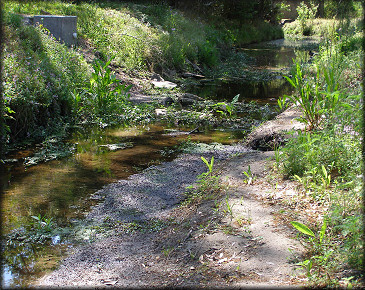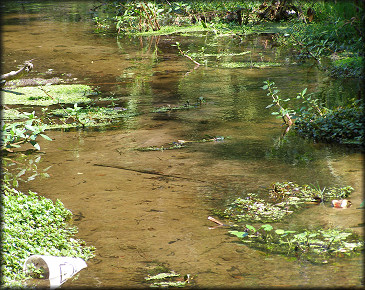|
Jones
Creek "Plant," Southeastern Duval County, Florida |
|
Jones Creek is one of
several normally small shallow urban drainage ditches that drain storm
water run-off from residential areas in the East Arlington area of
Jacksonville, Duval County, Florida to the St. Johns River. Other nearby
waterways which serve the same function include the periodically studied
Gunsmoke Creek that feeds into Holly Oaks lake before emptying into the
St. Johns River. Considering their source, neither waterway could be
considered pristine, especially in the downstream areas where they are
filled with the cast off debris of man, stagnant discolored water, and
rampant algae growth. However, one western tributary of Jones Creek,
although littered with debris, some 50 years after the area was
developed still has clear flowing water over a clean sandy bottom and
supports a thriving native freshwater bivalve population. This tributary
drains an apparent spring fed lake at
The Park at Regency Apartments before
passing close by a lake at the
Atrium Retirement Community on its way
to the river. The former has a healthy breeding Pomacea paludosa
population while the latter also has or had a resident Pomacea
population. It therefore seems likely that this section of Jones Creek
at one time in the distant past also was populated by the species. The
periodic dredging of the waterways by local government entities could
have resulted in their extirpation.
To test the suitability
of this waterway to support a breeding population of Pomacea paludosa,
a total of 18 adult Pomacea paludosa were collected from a lake
at the Florida State
College Jacksonville (FSCJ) South Campus
on 2-3 April, 2006 and introduced
into Jones Creek just south of Byrnes Road. This "plant" will be
monitored on a regular basis to ascertain its status and observations
will be entered below. |
|
 |
 |
|
Jones
Creek at the "Plant" site |
Observations:
- 4/4/2006 PM - A check of the
plant area revealed that all the transplanted specimens had
dispersed. No specimens could be located.
- 4/6/2006 PM - No live Pomacea
could be located. However, a
freshly dead/devoured specimen was
found in the plant area with significant shell damage.
- 4/8/2006 AM - No Pomacea
were observed. Eleven additional live specimens (nine from Floria
State College Jacksonville south campus and two from Lake Oneida
at the University of North Florida)
were planted in a more sheltered area of the creek.
- 4/13/2006 PM - No live Pomacea
could be found. However, two devoured specimens were located -
including one that had
significant shell damage.
- 4/29/2006 AM - A thorough search
was conducted but no Pomacea, living or dead, could be
located. Despite extremely dry conditions due to lack of
precipitation, water flow was still good.
- 5/3/2006 PM - None of the
previously planted specimens were seen (dead or alive). Twenty-seven
additional live specimens collected from a
small pond In Oceanway were
transplanted into the creek.
- 5/22/2006 PM - Three dead
Pomacea shells were located including one that was recently
deceased with operculum intact. No living specimens or egg clutches
could be located. Extremely dry weather conditions has reduced water
flow in the creek to only a trickle although deep pockets remain.
- 8/2/2006 PM - The entire length
of the plant area was thoroughly scrutinized and no Pomacea,
living or dead, could be located. However, three
Pomacea
egg clutches (one relatively
fresh and two that had previously hatched) were found on a concrete
culvert where the creek flows under Byrnes Road - a location just
downstream from the plant area. While at least some of the total of
56 transplanted specimens survived, mated, and ultimately deposited
egg clutches, it remains to be seen whether they will survive until
the next mating season during the spring of 2007.
- 5/10/2007 PM - With Pomacea
egg laying season in full swing throughout northeast Florida, the
concrete culvert area at Byrnes Road was thoroughly examined to
determine whether any new egg clutches had been deposited. However,
none could be located suggesting that a viable breeding population
had not survived the winter.
- 5/15/2010 - The site was examined
on a periodic basis since 2007 and no evidence was found to indicate
that any of the snails transplanted to the creek (or any their
offspring which hatched from the egg clutches) survived.
|
|
 |

